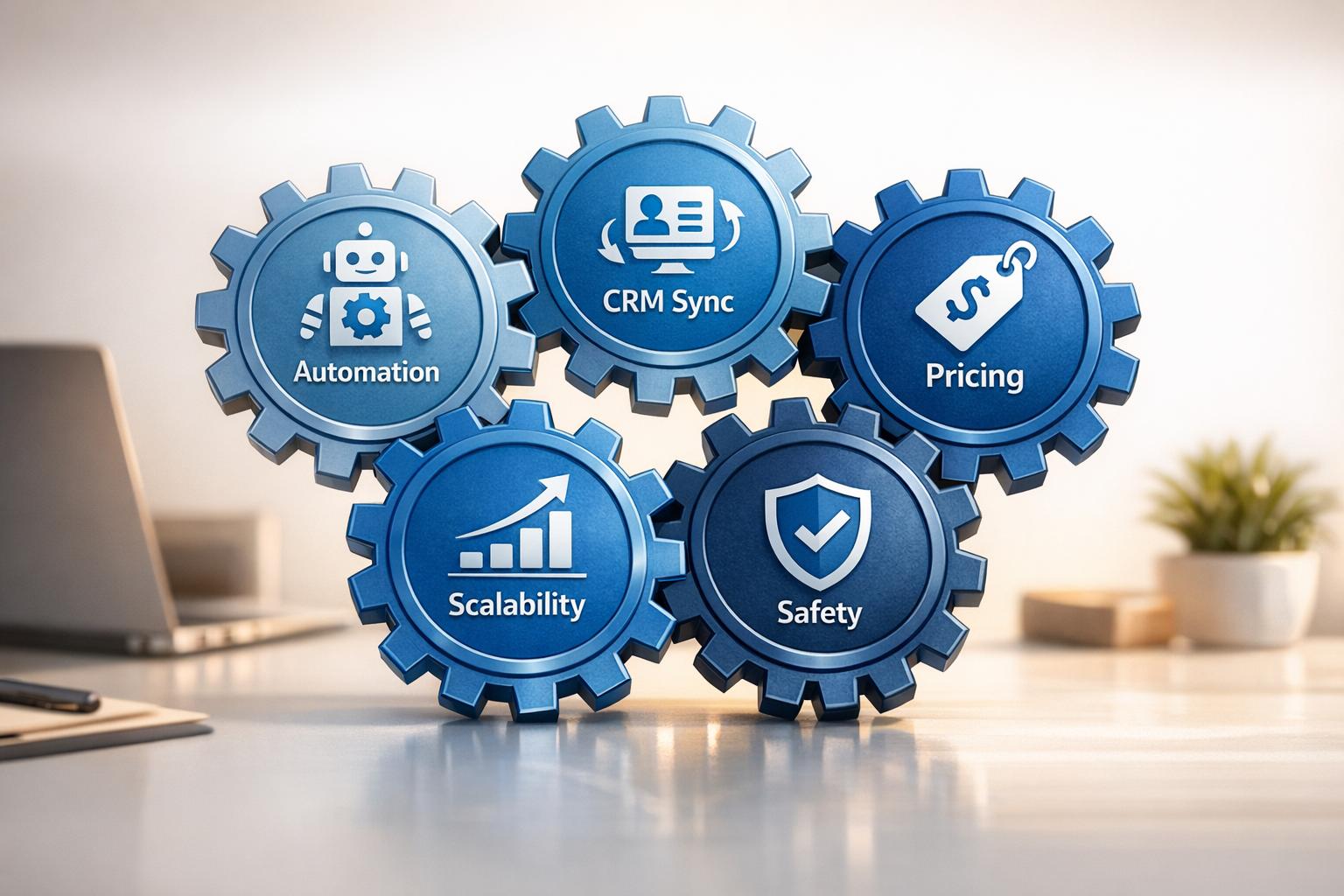
The Ultimate Guide to Sales Forecasting: Sales Forecasting 101 for Your Sales Team
Summary
Sales forecasting is a crucial component of any successful sales strategy. This article serves as the ultimate guide to sales forecasting, offering insights into the essential processes, tools, and methodologies needed to create accurate sales forecasts. Whether you're a sales manager or a sales rep, understanding and implementing effective sales forecasting can significantly impact your sales performance and future sales revenue.
Article Outline
- What is a Sales Forecast?
- Why is Accurate Sales Forecasting Important?
- Sales Forecasting 101: Getting Started with Basics
- The Sales Forecasting Process: Steps to Follow
- Common Sales Forecasting Methods and Techniques
- Tools and Software for Sales Forecasting
- Challenges in Sales Forecasting and How to Overcome Them
- How Sales Forecasting Impacts Your Sales Strategy
- Tips for Improving Sales Forecast Accuracy
- The Role of Sales Data in Forecasting
What is a Sales Forecast?
A sales forecast is a prediction of future sales revenue that uses historical sales data, current sales trends, and market conditions. It helps sales teams and sales managers set realistic sales goals and plan their strategies effectively.
Sales forecasting is an educated guess about future sales that can guide your sales team in making informed decisions. Accurate sales forecasts can help businesses allocate resources efficiently, manage inventory, and set achievable targets.
Here is a video to get a different view on sales forecasting:
Why is Accurate Sales Forecasting Important?
Accurate sales forecasting is crucial for several reasons. It enables businesses to predict future sales revenue accurately, helping them make informed decisions about budgeting, staffing, and production. Accurate sales forecasts also help in setting realistic sales goals and managing the sales pipeline effectively.
Without accurate sales forecasting, businesses risk overestimating or underestimating their future sales, leading to potential financial losses and missed opportunities. Inaccurate sales forecasts can result in poor resource allocation, excess inventory, and unmet sales quotas.
Sales Forecasting 101: Getting Started with Basics
Sales forecasting 101 involves understanding the basics of sales forecasting and implementing fundamental techniques to create accurate forecasts. Begin by collecting past sales data, analyzing sales trends, and identifying factors that impact your sales. Use this information to create a sales forecast that reflects your business's unique sales cycle and market conditions.
Sales managers should involve their sales team in the forecasting process to ensure that the forecast reflects the sales reps' insights and experiences. This collaborative approach can lead to more accurate sales forecasts and better alignment with the sales team's goals.
The Sales Forecasting Process: Steps to Follow
The sales forecasting process involves several key steps:
- Data Collection: Gather historical sales data, market trends, and other relevant information.
- Analysis: Analyze the collected data to identify patterns and trends.
- Forecasting Method Selection: Choose a forecasting method that suits your business needs.
- Forecast Creation: Use the selected method to create a sales forecast.
- Review and Adjust: Regularly review and adjust the forecast based on actual sales performance and new data.
By following these steps, sales teams can create accurate sales forecasts that guide their sales strategies and help them achieve their sales goals.
Common Sales Forecasting Methods and Techniques
Several sales forecasting methods can be used to predict future sales. Some common techniques include:
- Historical Sales Data Analysis: Using past sales data to predict future sales.
- Market Research: Conducting market research to understand trends and customer behavior.
- Sales Rep Estimates: Gathering estimates from sales reps based on their experience and knowledge.
- Statistical Models: Using statistical models and algorithms to forecast sales.
Here is a Comparison of Sales Forecasting Methods:
Each method has its strengths and weaknesses, and businesses may use a combination of methods to create the most accurate sales forecast.
Tools and Software for Sales Forecasting
Various sales forecasting tools and software can help businesses create accurate sales forecasts. These tools often include features like data analysis, trend identification, and predictive modeling. Some popular sales forecasting software includes Salesforce, HubSpot, and Zoho CRM.
For more advanced tools, SalesMind AI offers LinkedIn Prospecting Automation, which integrates sales analytics to enhance forecasting accuracy. These tools can streamline the forecasting process, making it easier for sales teams to create and manage their forecasts. By using advanced analytics and machine learning algorithms, these tools can provide more accurate and reliable sales forecasts.
Challenges in Sales Forecasting and How to Overcome Them
Sales forecasting comes with several challenges, such as data accuracy, market volatility, and changing customer behavior. To overcome these challenges, businesses should:
- Ensure Data Accuracy: Regularly update and clean sales data to maintain accuracy.
- Monitor Market Trends: Stay informed about market trends and adjust forecasts accordingly.
- Involve the Sales Team: Engage the sales team in the forecasting process to gain valuable insights and improve forecast accuracy.
By addressing these challenges, businesses can improve their sales forecasting accuracy and make more informed decisions.
How Sales Forecasting Impacts Your Sales Strategy
Sales forecasting plays a crucial role in shaping your sales strategy. Accurate sales forecasts help sales leaders set realistic sales goals, allocate resources efficiently, and manage the sales pipeline effectively. By understanding future sales trends, businesses can plan their sales activities and marketing campaigns to maximize revenue.
Sales forecasting also helps in identifying potential risks and opportunities, allowing sales teams to take proactive measures to address them. This can lead to improved sales performance and better alignment with overall business objectives.
Tips for Improving Sales Forecast Accuracy
To improve sales forecast accuracy, businesses can implement the following tips:
- Use Reliable Data Sources: Ensure that the data used for forecasting is accurate and up-to-date.
- Regularly Review and Adjust Forecasts: Continuously monitor sales performance and adjust forecasts as needed.
- Involve Multiple Stakeholders: Engage various stakeholders, including sales reps and sales managers, in the forecasting process to gain diverse perspectives.
By following these tips, businesses can create more accurate sales forecasts that guide their sales strategies and help them achieve their goals.
The Role of Sales Data in Forecasting
Sales data plays a vital role in sales forecasting. Historical sales data provides the foundation for predicting future sales trends and setting realistic sales goals. By analyzing past sales data, businesses can identify patterns and trends that inform their sales forecasts.
Sales data also helps in tracking the performance of sales reps and understanding the effectiveness of different sales strategies. By leveraging sales data, businesses can make more informed decisions and improve their sales performance.
Enhanced Forecasting Techniques for Better Sales Performance
Improving your forecasting techniques is essential for building an accurate sales forecast. Utilizing sales analytics and understanding the length of the sales cycle can help in creating a sales forecast that aligns with your sales targets. Employing multiple forecasting techniques and tools allows sales organizations to better forecast sales and achieve their goals.
Sales forecasting allows businesses to anticipate market changes and adjust their strategies accordingly. Accurate forecasting helps in managing the current sales pipeline and predicting the status of the current sales, ensuring that sales reps are informed and can communicate effectively with prospects.
Factors That Impact Sales Forecasting
Several factors can impact sales forecasting, including market conditions, economic trends, and the performance of individual sales reps. Understanding these factors is crucial for achieving sales forecasting accuracy. Sales managers should track the age of the sales opportunity and the length of the sales cycle to make more precise forecasts.
Sales forecasting is different from other business processes because it involves making an educated guess about future sales. By considering various factors that impact sales forecasting, businesses can make more accurate predictions and improve their overall sales performance.
Understanding Sales Forecasting Challenges
Sales forecasting challenges are common in many sales organizations. These challenges can arise from fluctuating market conditions, data inconsistencies, and the unpredictable nature of customer behavior. Addressing these challenges requires a strategic approach, including the use of sales analytics for accurate forecasting and leveraging multiple forecasting techniques.
Creating a sales forecast that is both realistic and flexible can help mitigate these challenges. Sales forecasting allows businesses to prepare for various scenarios, ensuring they remain resilient in the face of uncertainties. By using two or more sales forecasting methodologies, companies can enhance the reliability of their forecasts and better navigate sales forecasting challenges.
Impact of Sales Forecasting on Sales Performance
Sales forecasting has a significant impact on sales performance as a company. By accurately forecasting future sales revenue, businesses can set achievable sales targets and track progress against these goals. This helps in maintaining a clear focus and aligning the efforts of the sales team towards common objectives.
Using sales forecasting to monitor the status of the current sales pipeline can provide valuable insights into the effectiveness of different sales strategies. This allows sales managers to make data-driven decisions and adjust their approach to maximize sales performance.
To further enhance your sales forecasting capabilities, consider signing up for SalesMind AI's advanced tools. Register here to get started.
Summary of Key Takeaways
- Understanding Sales Forecasting: Sales forecasting is the process of predicting future sales revenue using historical data, market trends, and other factors.
- Importance of Accuracy: Accurate sales forecasting is crucial for effective resource allocation, inventory management, and goal setting.
- Steps in the Forecasting Process: The sales forecasting process involves data collection, analysis, method selection, forecast creation, and regular review.
- Methods and Tools: Common forecasting methods include historical data analysis, market research, and statistical models. Popular forecasting tools include Salesforce, HubSpot, and Zoho CRM.
- Overcoming Challenges: Address challenges like data accuracy and market volatility by involving the sales team and staying informed about market trends.
- Impact on Sales Strategy: Sales forecasting helps set realistic goals, allocate resources efficiently, and manage the sales pipeline effectively.
- Improving Accuracy: Use reliable data, regularly review forecasts, and involve multiple stakeholders to improve forecast accuracy.
- Role of Sales Data: Sales data is essential for identifying trends, tracking performance, and making informed decisions.
- Enhanced Forecasting Techniques: Utilize sales analytics and multiple forecasting techniques to improve sales forecast accuracy.
- Impact of External Factors: Understand and monitor external factors that can impact sales forecasting for better predictions.
By understanding and implementing these key aspects of sales forecasting, businesses can enhance their sales strategies and achieve their sales goals effectively. This ultimate guide to sales forecasting provides a comprehensive overview of the tools, techniques, and processes needed to create accurate and reliable sales forecasts. For more resources, visit the SalesMind AI home page.


.avif)


